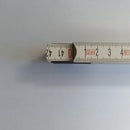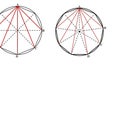Introduction: How to Insert a Skewer Into a Styrofoam Ball Without Using Woodworking Tools
- Many projects require the insertion of a skewer into the center of a Styrofoam ball without explaining how to perform this operation. One can only assume that the authors of these projects use guesswork to perform this procedure.
- This instructable illustrates a procedure that does not involve guesswork.
- Two cubic cardboard boxes are made. One box, the fixture or holder, contains the ball and acts as a clamp to stop the ball rolling when a skewer is inserted into the ball. The other box, the jig, acts as a guide to allow insertion of the skewer through the holder and ball at right angles to one of the surfaces of the holder box.
Step 1: Materials
- Two pieces of cardboard (for example, cardboard from a cereal box);
- Packing tape;
- Scissors;
- Bamboo skewer;
- Metal pointed object with a diameter no larger than that of the skewer;
- Ballpoint pen or pencil;
- Ruler.
Step 2: Drawing
On each piece of cardboard draw a rectangle made up of 12 squares as shown in the above figure. The side length of each of the squares is equal to the diameter of the Styrofoam ball.
The figure inside the solid lines will be used for making the net for a cube when it is cut out from the rectangle.
The remaining squares outside the solid lines will be used for packing the inside of the fixture to ensure that the sphere fits snugly inside this cube.
Draw diagonals from the corners of the two squares in the net that will form the top and bottom sides of the cubes.
The points where the diagonals intersect are the centers of the squares.
Step 3: Cutting
On both pieces of cardboard cut out the rectangles using scissors.
Then, on each rectangle cut along the solid lines.
Keep the remaining squares and rectangles made up of two squares for possible use in Step 7.
Step 4: Piercing
Poke a hole with a metal pointed object into the centers of the crosses drawn on the net. These holes will be opposite one another when the boxes are constructed.
The skewer will be inserted into these holes, so the diameter of the metal object should be no greater than that of the skewer.
Step 5: Bending
Bend the cardboard along the edges of adjacent squares of the nets. For bending the cardboard a ruler can be used to help keep the bend straight along each edge by holding the ruler along an edge with one hand and using the other hand to lift the cardboard upwards on the square adjacent to the ruler.
Step 6: Sticking
Fold the squares of the net along the bent lines so that they form a cube and tape adjacent edges of the cubes, leaving the lid open on one of the cubes (the fixture).
Step 7: Inserting a Skewer
Place the ball in the fixture cube and make sure the ball fits snugly in the cube. If it fits loosely, insert one or more pieces of cardboard squares (made in Step 3) on each of the four inside surfaces of the fixture so that the ball does not fall out of the box when the box is inverted with the lid open.
Insert the pointed end of the skewer into one of the holes made in the jig and move it around to find its opposite hole in the jig. Once found, insert the skewer through this hole.
With the fixture cube sitting on a firm surface, line up the pointed tip of the skewer with the central hole on the top of the fixture cube, close its lid and lower the jig so that it sits directly on top of fixture containing the ball.
While holding the jig and fixture, push the skewer through the fixture and ball. The tip of the skewer does not need to go all the way through to the bottom of the fixture cube.
Step 8: Removing the Skewer and Ball
With the skewer remaining in place in the ball, slide the jig through the skewer away from the fixture.
Then, open the lid of the fixture and slide the skewer out of the lid of the fixture. The skewer with the attached ball can be now pushed all the way through the ball.
Step 9: Testing
Hold the ends of the skewer between the thumb and index finger of both hands and rotate one end of the skewer while holding the other end of the skewer loosely between the thumb and index finger of the opposite hand. The closer the skewer passes through the center of the ball, the less wobble is seen in the ball as the skewer is rotated.





